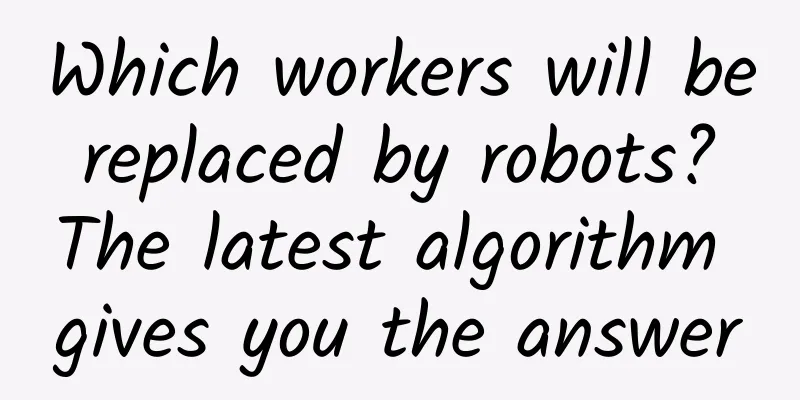Which workers will be replaced by robots? The latest algorithm gives you the answer

|
When people think about a future with intelligent robots, the first question they usually ask is: How many jobs will they eliminate? Whatever the answer, the second question is likely to be: How can I make sure mine isn’t one of them? Recently, a new result was published in the journal Science Robotics, in which robotics experts from the Swiss Federal Institute of Technology in Lausanne (EPFL) and economists from the University of Lausanne provided answers to these two questions. By combining scientific and technical literature on robot capabilities with employment and wage statistics, the researchers developed a method for calculating which existing jobs are more likely to be performed by machines in the near future. In addition, they designed a method to provide recommendations for transitioning these high-risk occupations to jobs that are less risky and require minimal retraining. The results showed that out of 1,000 occupations ranked, "physicists" were the least at risk of being replaced by machines, while "slaughterhouse workers and meatpackers" faced the highest risk. In general, jobs in food processing, construction, maintenance and mining industries appeared to be at the highest risk. The Fourth Industrial Revolution: Competition between Workers and Robots Robotics and artificial intelligence (AI) are often referred to as the core of the Fourth Industrial Revolution. Continued advances in these fields are leading to robots that can participate in all aspects of human society more autonomously, more dexterously, and more safely than their predecessors. Intelligent systems have also surpassed humans in tasks that once seemed impossible for machines to accomplish, such as the very complex game of Go. These advances, coupled with equally important breakthroughs in high-performance computing, the Internet of Things, and new materials, are already having a clear impact on manufacturing and service industries. Therefore, it is expected that in the coming decades, humanity’s entire economic and production system will undergo extensive transformation. (Source: Pixabay) While many analysts predict that this revolution will have a positive impact on overall productivity and growth, its potential impact on employment has attracted much attention. Robotics and artificial intelligence look poised to automate many tasks currently done by humans and reduce the need for human work in many sectors of the economy. On the surface, this is nothing new: past waves of automation (such as the mechanization of the textile and agricultural sectors, the introduction of industrial robots in manufacturing, and the computerization of the service sector) initially increased the labor force, but then significantly reduced the demand for human employment. In fact, in past waves of automation, machines mostly replaced humans in low-skilled, manual, repetitive jobs. It has been suggested that the societal impact of the Fourth Industrial Revolution will be quite different, as the next wave of robotics and artificial intelligence will also affect medium and high-skill jobs, including those with relevant cognitive and creative components, as well as areas requiring manual craftsmanship that have so far remained untouched by automation. (Source: Pixabay) While the impact on productivity and overall economic growth may still be positive in the long run, the transition is likely to be painful. Previous studies have predicted how many jobs will be automated by robots, but they have mostly focused on software robots, such as speech and image recognition, financial robot advisors, chatbots, etc. Moreover, these predictions fluctuate wildly depending on job requirements and how software capabilities are assessed. "In this latest study, we considered not just AI software but truly intelligent robots that perform manual work, and we developed a system to compare the capabilities of humans and robots in hundreds of jobs," says Professor Dario Floreano, director of EPFL's Intelligent Systems Laboratory. Measure your risk of being replaced by a machine. What if? To predict the risk of most jobs being replaced by machines, the researchers looked at the European H2020 Multi-Annual Roadmap (MAR) for Robotics, a strategic document from the European Commission that is regularly revised by robotics experts. The MAR describes dozens of capabilities that current robots require or may require in the future, organized into categories such as manipulation, insight, perception, and interaction with humans. MAR describes dozens of capabilities that current robots need or that future robots may need, organized into categories such as manipulation, insight, perception, and interaction with humans. The researchers then assessed the maturity of robotic capabilities by examining descriptions of papers, patents, and robotic products, using a well-known scale to measure the level of technological development, known as the “technology readiness level” (TRL). (Source: EPFL) For human capabilities, the researchers relied on the O*net database, a widely used resource on the U.S. job market that categorizes about 1,000 occupations and covers the skills and knowledge that are most important for each. After selectively matching the human capabilities in the O*net list with the robot capabilities in the MAR document, the team can calculate the likelihood that each existing job occupation could be performed by a robot. For example, a job that requires humans to work with millimeter-level motion precision, which robots are very good at, would have the highest TRL for that capability. If a job requires enough of these skills, it is more likely to be automated than a job that requires capabilities such as critical thinking or creativity. An Automation Risk Index (ARI) was calculated and ranked for 1,000 jobs, showing that "physicists" are at the lowest risk of being replaced by machines, while "butchers and meat packers" face the highest risk. Figure | Automation risk index of five occupations (Source: Science) Figure | Automation risk index of different industries (Source: Science) The researchers then created a method to find, for any given occupation, alternative jobs that have a significantly lower risk of automation and are reasonably close to the original job in terms of required competencies and knowledge, thereby minimizing retraining costs and making occupational transitions feasible. "The main challenge facing society today is how to cope with automation," said Rafael Lalive, a professor at the University of Lausanne who co-led the study. "Our work provides detailed career advice for workers at high risk of automation, while repurposing many of the skills acquired in their old jobs so they can move into safer jobs. With this advice, governments can support societies to become more resilient to cope with the wave of automation." To test how the approach performs in real life, the researchers used data from the U.S. Department of Labor and simulated thousands of career moves based on the algorithm’s recommendations, finding that it can indeed allow workers in high-risk occupations to move to medium-risk occupations while receiving relatively low-cost retraining efforts. The researchers say governments could use the approach to measure how many workers may be at risk of automation and adjust retraining policies, companies could assess the costs of increasing automation, robot manufacturers could better tailor their products to market needs, and the public could identify the easiest path to reposition themselves in the job market. Finally, the researchers transformed the new method and data into an algorithm that predicts the risk of automation replacement for hundreds of jobs and recommends resilient career transitions with minimal retraining. (Openly accessible at: https://lis2.epfl.ch/resiliencetorobots) As can be seen from the above picture: the risk of academics being replaced by robots is quite high... References: https://www.science.org/doi/10.1126/scirobotics.abg5561 https://actu.epfl.ch/news/how-to-compete-with-robots/ Academic headlines |
<<: How well do you know the human body?
Recommend
13 creative ways to play events, a must-have for marketing in 2020!
The homogeneity of current market competition is ...
The ideal product operator has this kind of thinking...
Product operation is inseparable, and a good prod...
Honor Play 6X unboxing: dual-camera flagship rewrites the thousand-yuan phone landscape
With the continuous innovation of products, dual-...
“Justice League” that can save Android devices from lag is here!
The "Android Unified Push Alliance", wh...
Popular Science | Pineapples are not only edible, but can also be a luxury item?
It's the season for pineapples again. Pineapp...
Collection level! Not only WeChat and Alipay, this article will show you all the mini program platforms
There are more and more platforms for mini progra...
Mark's Favorite Musk July and August 2021 Courses
Mark's Favorite Musk July and August 2021 Cou...
The 10 hottest growth strategies of 2019
There are two obvious trends in 2019: as the traf...
I would like to call this Android automation APP a magic tool!
[[385362]] Friends who have used Android phones s...
Understand the four key points of professional trader training: analysis of main force behavior!
Understand the four key points of professional tr...
Analysis: How does "Yi Er San" operate its products?
Yiersan is a clothing rental platform for women a...
2022 Chengdu Tea Tasting Studio Contact Guide
Chengdu Tea Tasting Studio has its own appointmen...
How do big companies like Tik Tok and Duoduo APP carry out promotion and marketing?
It is already the beginning of 2019, and the New ...
Why can a can that can’t be opened be opened by tapping the bottom?
Do you like to eat this kind of canned fruit in g...
The Queqiao-2 relay satellite is scheduled to be launched in 2024. What will the satellite of the satellite do?
China Science and Technology News Network, Januar...









